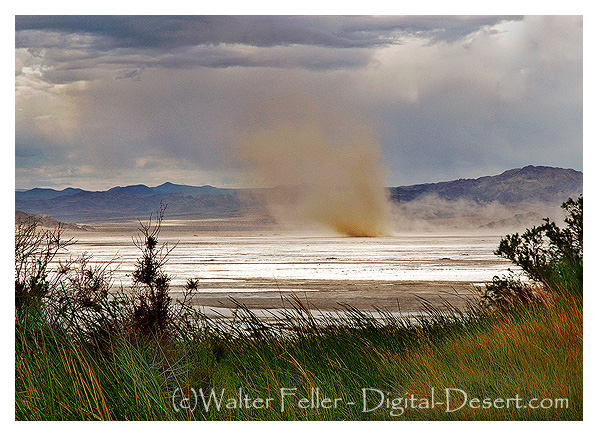Wind-induced Sand Movement

Dust storm, Soda Lake, Mojave National Preserve
Individual sand grains are moved under the force of the wind in two distinct ways: saltation and surface creep. The primary method of sand movement is saltation. As wind moves over a sand deposit, it is able to pick up grains from the surface and give them a forward momentum, but the weight of the sand grains soon bring the grains back to the surface. If the surface is composed of coarse, immobile particles, such as pebbles, the sand grains will bounce directly off the hard surface and back into the air, where the wind will once again provide a forward momentum. These bouncing grains can move downwind at about half the speed of the wind. If the surface is composed of finer sand grains, however, a saltating sand grain will not bounce off the surface; rather, it will strike the sandy surface and bury itself. the impact will eject a second grain into the air to be blown downwind. This "splashing" form of saltation results in a slower rate of downwind movement than the bouncing motion on hard surfaces. Either process falls under the definition of saltation (Bagnold, 1941).
Saltation of sand grains along the surface accounts for about 75% of all sand movement by wind. However, due to the fact that sand grains average about two thousand times the weight of the atmosphere, not all winds will move sand. Wind speeds must reach what Bagnold (1941) calls a "fluid threshold", defined as the wind speed necessary for sand to start saltating under the direct pressure of the wind. The fluid threshold varies in direct proportion to the predominant grain size of the sand surface, generally ranging from ten to twenty miles per hour (Bagnold, 1941; Sharp, 1963).
After sand grains start moving under direct wind pressure, wind speeds lower than the fluid threshold can maintain sand movement. Once saltation has begun, direct wind pressure is no longer necessary to lift sand grains into the air. The impact of saltating grains provides enough energy to knock new grains into the air (assuming a sandy surface); thus, the wind need provide only enough energy to move the airborne grains downwind. The wind speed necessary to maintain saltation once it has begun is termed the "impact threshold" and defined by Bagnold (1941, p.32) as the velocity at which "the energy received by the average saltating grains becomes equal to that lost (by impact), so that motion is sustained." Like the fluid threshold, the impact threshold increases with increasing grain size.
Saltating sand grains usually stay close to the surface. In his wind tunnel experiments, Bagnold (1941) found the average height of windblown sand to be about ten centimeters, although both height and speed of saltating grains increased with wind speed. At Kelso dunes, a fifteen-year study indicated that 90% of saltating grains moved within sixty-four centimeters of the surface, with maximum sand-blast effect at twenty-three centimeters (Sharp and Saunders, 1978).
The overall volume of sand moved has an exponential relationship with wind velocity, i.e. as wind speeds increase, the downwind rate of sand movement increases exponentially. Even during intense "sand storms," however, at maximum wind speeds and sand movement, saltating grains rarely exceed two meters in height (Fryberger et al., 1979).
Due to an increased fluid threshold, heavier sand grains are rarely moved directly by wind pressure. Only intense storm winds can lift the heavier grains off the surface. Grains larger than one millimeter in diameter are generally moved by a second process called surface creep (Bagnold, 1941; Sharp, 1966). When saltating sand grains strike these heavy grains on the surface, they don't have enough energy to knock them into the air, but they do impart to the heavy grains a slight forward momentum along the surface. In this way, heavy sand grains up to two hundred times the mass of the saltating grains can be slowly moved downwind. Up to 25% of all wind-transported sand is moved by surface creep (Bagnold, 1941).